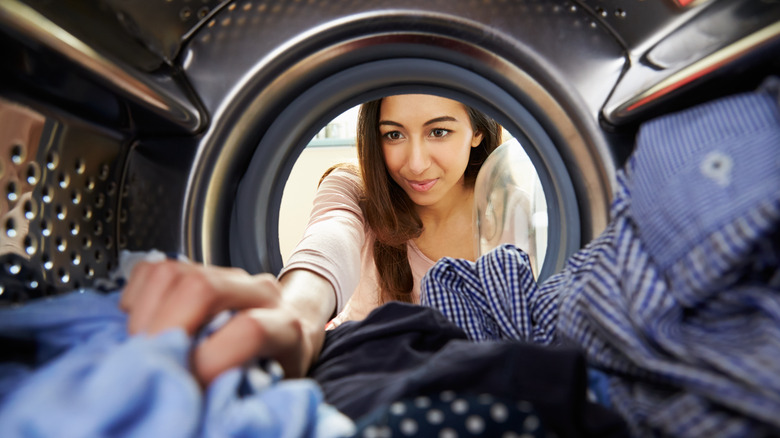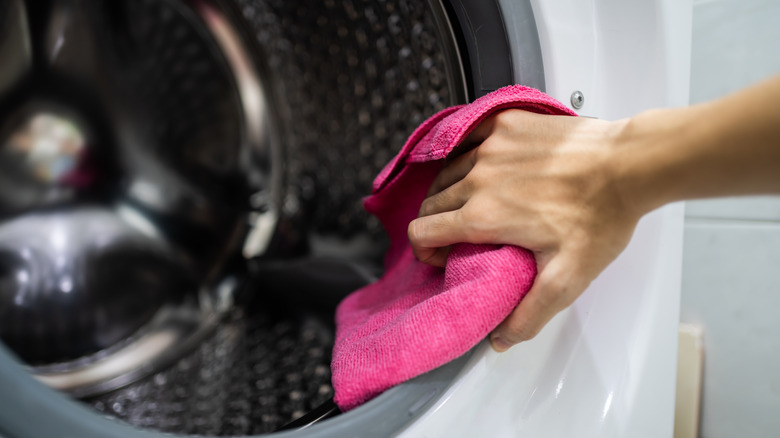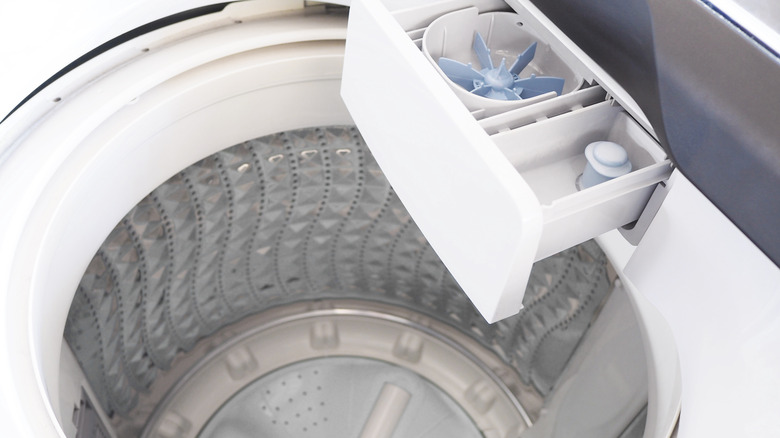Here's How To Clean The Inside Of Your Washing Machine
While it's easy to assume that appliances that are designed for cleaning will automatically clean themselves during a cycle, the reality is that your washing machine is likely harboring tons of bacteria, dirt, and grime. Because the dirt that gets washed from your clothes doesn't just magically disappear after a cycle in the wash, it has to go somewhere — and if you aren't regularly cleaning your washing machine, that somewhere can often be the washing machine itself.
According to Home Revolution, residue and deposits from your laundry detergent can build up inside your washing machine, creating a thin veil that can trap and lock bacteria. This buildup of bacteria and grime can clog the mechanisms inside your machine and damage it, while also preventing the water used for your laundry cycles from reaching a certain temperature.
The hot, humid environment inside a washing machine is the perfect breeding ground for germs and bacteria, and if not cleaned regularly, it can lead to an accumulation of mold and mildew. Going long periods of time without cleaning the inside of your washing machine has the potential to not only damage your machine long term and render it less effective, but also any odor and bacteria buildup that starts to accumulate can easily be transferred to your clothes in the wash.
Knowing how to properly clean your washing machine will help ensure it is working as efficiently as possible while also protecting your clothing and your health.
How to clean your washing machine
One of the first signs of mold and mildew buildup on the inside of a washing machine is a strong, smelly odor. According to Appliance Rescue Service, you can tackle the smell with bleach. Simply run an empty cycle on the machine with a half cup of bleach instead of detergent — making sure to add an extra rinse cycle to ensure all the bleach is rinsed from the machine before washing clothes in it again. The bleach will sterilize the drum and should take care of the odor.
If you are dealing with issues beyond odor, such as dirt, residue, and hard water buildup, a simple cycle of bleach won't do the job as well as a little elbow grease. Start by taking apart anything on the inside of the machine that you notice as being easily removable. There's a strong likelihood there is lots of grime hidden in parts of the machine that you won't be able to see without taking it apart.
Appliance Rescue Service then recommends using a mixture of white vinegar and dish soap and scrubbing all visible parts of the machine with a toothbrush dipped into the mixture. After scrubbing the machine and all its removable parts, pour four cups of white vinegar into the empty machine and run it on the longest and hottest cycle, followed by one more cycle with just water to rinse any remaining traces of vinegar.
How often you should clean your washing machine
Cleaning a particularly grimy washing machine can be quite the undertaking, which is why it's best not to let it get bad in the first place. Courtenay Hartford, author of "The Cleaning Ninja," said "Cleaning your washer should be viewed as more of a preventative measure than as something that you do to fix a problem once it arises," per Martha Stewart. You should be giving your washing machine a thorough cleaning about once a month. Not giving bacteria a chance to grow in the first place is the best practice when it comes to maintaining your machine.
If you clean your washing machine monthly but still notice your clothes aren't smelling quite as fresh as they should straight out of the machine, Martha Stewart suggests keeping the door of your washing machine open at least an inch between laundry cycles, which will give the inside a chance to fully dry out before getting wet again.
Gently wiping dry the seals on your washing machine and regularly cleaning the filters and drains near the seal will also help to ensure both you and your washing machine get the most out of your monthly cleanings.



